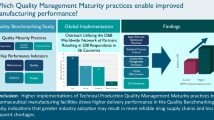Abstract
The manufacturing of biologic medicines (biologics) requires robust process and facility design, rigorous regulatory compliance, and a well-trained workforce. Because of the complex attributes of biologics and their sensitivity to production and handling conditions, manufacturing of these medicines also requires a high-reliability manufacturing organization. As required by regulators, such an organization must monitor the state-of-control for the manufacturing process. A high-reliability organization also invests in an experienced and fully engaged technical support staff and fosters a management culture that rewards in-depth analysis of unexpected results, robust risk assessments, and timely and effective implementation of mitigation measures. Such a combination of infrastructure, technology, human capital, management, and a science-based operations culture does not occur without a strong organizational and financial commitment. These attributes of a high-reliability biologics manufacturer are difficult to achieve and may be differentiating factors as the supply of biologics diversifies in future years.





Similar content being viewed by others
References
Gatesman ML, Smith TJ. The shortage of essential chemotherapy drugs in the United States. N Engl J Med. 2011;365(18):1653–5.
Kaakeh R, Sweet BV, Reilly C, Bush C, DeLoach S, Higgins B, et al. Impact of drug shortages on U.S. health systems. Am J Health Syst Pharm. 2011;68(19):1811–9.
Ventola CL. The drug shortage crisis in the United States: causes, impact, and management strategies. P T. 2011;36(11):740–57.
US Food and Drug Administration. Current drug shortages. http://www.fda.gov/Drugs/DrugSafety/DrugShortages/ucm050792.htm. Accessed 13 Nov 2012.
Woodcock J, Wosinska M. Economic and technological drivers of generic sterile injectable drug shortages. Clin Pharmacol Ther. 2013;93(2):170–6.
Weick KE, Sutcliffe KM. Managing the unexpected: resilient performance in an age of uncertainty. 2nd ed. San Francisco: Wiley; 2007.
Sasaki H, Bothner B, Dell A, Fukuda M. Carbohydrate structure of erythropoietin expressed in Chinese hamster ovary cells by a human erythropoietin cDNA. J Biol Chem. 1987;262(25):12059–76.
Egrie JC, Browne JK. Development and characterization of novel erythropoiesis stimulating protein (NESP). Br J Cancer. 2001;84(Suppl 1):3–10.
Hokke CH, Bergwerff AA, van Dedem GW, van Oostrum J, Kamerling JP, Vliegenthart JF. Sialylated carbohydrate chains of recombinant human glycoproteins expressed in Chinese hamster ovary cells contain traces of N-glycolylneuraminic acid. FEBS Lett. 1990;275(1–2):9–14.
Ghaderi D, Taylor RE, Padler-Karavani V, Diaz S, Varki A. Implications of the presence of N-glycolylneuraminic acid in recombinant therapeutic glycoproteins. Nat Biotechnol. 2010;28(8):863–7.
Prigge ST, Kolhekar AS, Eipper BA, Mains RE, Amzel LM. Amidation of bioactive peptides: the structure of peptidylglycine alpha-hydroxylating monooxygenase. Science. 1997;278(5341):1300–5.
Boven K, Stryker S, Knight J, Thomas A, van Regenmortel M, Kemeny DM, et al. The increased incidence of pure red cell aplasia with an Eprex formulation in uncoated rubber stopper syringes. Kidney Int. 2005;67(6):2346–53.
Haag-Weber M, Eckardt KU, Horl WH, Roger SD, Vetter A, Roth K. Safety, immunogenicity and efficacy of subcutaneous biosimilar epoetin-alpha (HX575) in non-dialysis patients with renal anemia: a multi-center, randomized, double-blind study. Clin Nephrol. 2012;77(1):8–17.
Seidl A, Hainzl O, Richter M, Fischer R, Bohm S, Deutel B, et al. Tungsten-induced denaturation and aggregation of epoetin alfa during primary packaging as a cause of immunogenicity. Pharm Res. 2012;29(6):1454–67.
Joubert MK, Hokom M, Eakin C, Zhou L, Deshpande M, Baker MP, et al. Highly aggregated antibody therapeutics can enhance the in vitro innate and late-stage T-cell immune responses. J Biol Chem. 2012;287(30):25266–79.
Sauerborn M, Brinks V, Jiskoot W, Schellekens H. Immunological mechanism underlying the immune response to recombinant human protein therapeutics. Trends Pharmacol Sci. 2010;31(2):53–9.
Jiang Y, Nashed-Samuel Y, Li C, Liu W, Pollastrini J, Mallard D, et al. Tungsten-induced protein aggregation: solution behavior. J Pharm Sci. 2009;98(12):4695–710.
Zhang B, Towers EW, Poppe L, Cockrill SL. Analytical characterization of a novel degradation product in a PEGylated recombinant protein. J Pharm Sci. 2011;100(11):4607–16.
Vinther A. A novel bacterial contamination in cell culture manufacturing Leptospira licerasiae. PDA WCC Meeting July 19, 2012. http://www.wccpda.org/Pages/Archives/Anders%20Vinther%20Leptospira%20PDA%20WCC%2019%20Jul%202012.ppt. Accessed 30 Nov 2012.
US Food and Drug Administration. Quality systems. http://www.fda.gov/Drugs/DevelopmentApprovalProcess/Manufacturing/ucm278584.htm. Accessed 13 Nov 2012.
US Food and Drug Administration. FDA Form 483 frequently asked questions. http://www.fda.gov/ICECI/EnforcementActions/ucm256377.htm. Accessed 30 Nov 2012.
Pritchett T. A 483 primer: learning from the mistakes of others. Bioprocess Int. 2011;9:12–6.
US Food and Drug Administration. Regulatory procedures manual, Chapter 4: advisory actions. http://www.fda.gov/downloads/ICECI/ComplianceManuals/RegulatoryProceduresManual/UCM074330.pdf. Accessed 20 Feb 2013.
US Food and Drug Administration. About Warning and Close-Out Letters. http://www.fda.gov/ICECI/EnforcementActions/WarningLetters/ucm278624.htm. Accessed 30 Nov 2012.
US Food and Drug Administration. Inspections, compliance, enforcement, and criminal investigations. http://www.fda.gov/ICECI/EnforcementActions/WarningLetters/default.htm. Accessed 30 Nov 2012.
US Food and Drug Administration. News & events. http://www.fda.gov/NewsEvents/Newsroom/PressAnnouncements/ucm289224.htm. Accessed 30 Nov 2012.
US Food and Drug Administration. Regulatory procedures manual, Chapter 5: administrative actions. http://www.fda.gov/downloads/ICECI/ComplianceManuals/RegulatoryProceduresManual/UCM074324.pdf. Accessed 20 Feb 2013.
Genazzani AA, Biggio G, Caputi AP, Del Tacca M, Drago F, Fantozzi R, et al. Biosimilar drugs: concerns and opportunities. Biodrugs. 2007;21(6):351–6.
Prugnaud JL. Similarity of biotechnology-derived medicinal products: specific problems and new regulatory framework. Br J Clin Pharmacol. 2008;65(4):619–20.
Roger SD. Biosimilars: how similar or dissimilar are they? Nephrology (Carlton). 2006;11(4):341–6.
Gottlieb S. Biosimilars: policy, clinical, and regulatory considerations. Am J Health Syst Pharm. 2008;65(14 Suppl 6):S2–8.
Acknowledgments
Gustavo Grampp and Sundar Ramanan are employees of Amgen Inc. and own stock in Amgen Inc. Gustavo Grampp devised the concept for this paper; Gustavo Grampp and Sundar Ramanan wrote the paper; Amgen Inc. approved the manuscript for submission. Kathryn Boorer PhD of Amgen Inc. provided editorial assistance.
Author information
Authors and Affiliations
Corresponding author
Rights and permissions
About this article
Cite this article
Grampp, G., Ramanan, S. Managing Unexpected Events in the Manufacturing of Biologic Medicines. BioDrugs 27, 305–316 (2013). https://doi.org/10.1007/s40259-013-0018-5
Published:
Issue Date:
DOI: https://doi.org/10.1007/s40259-013-0018-5




